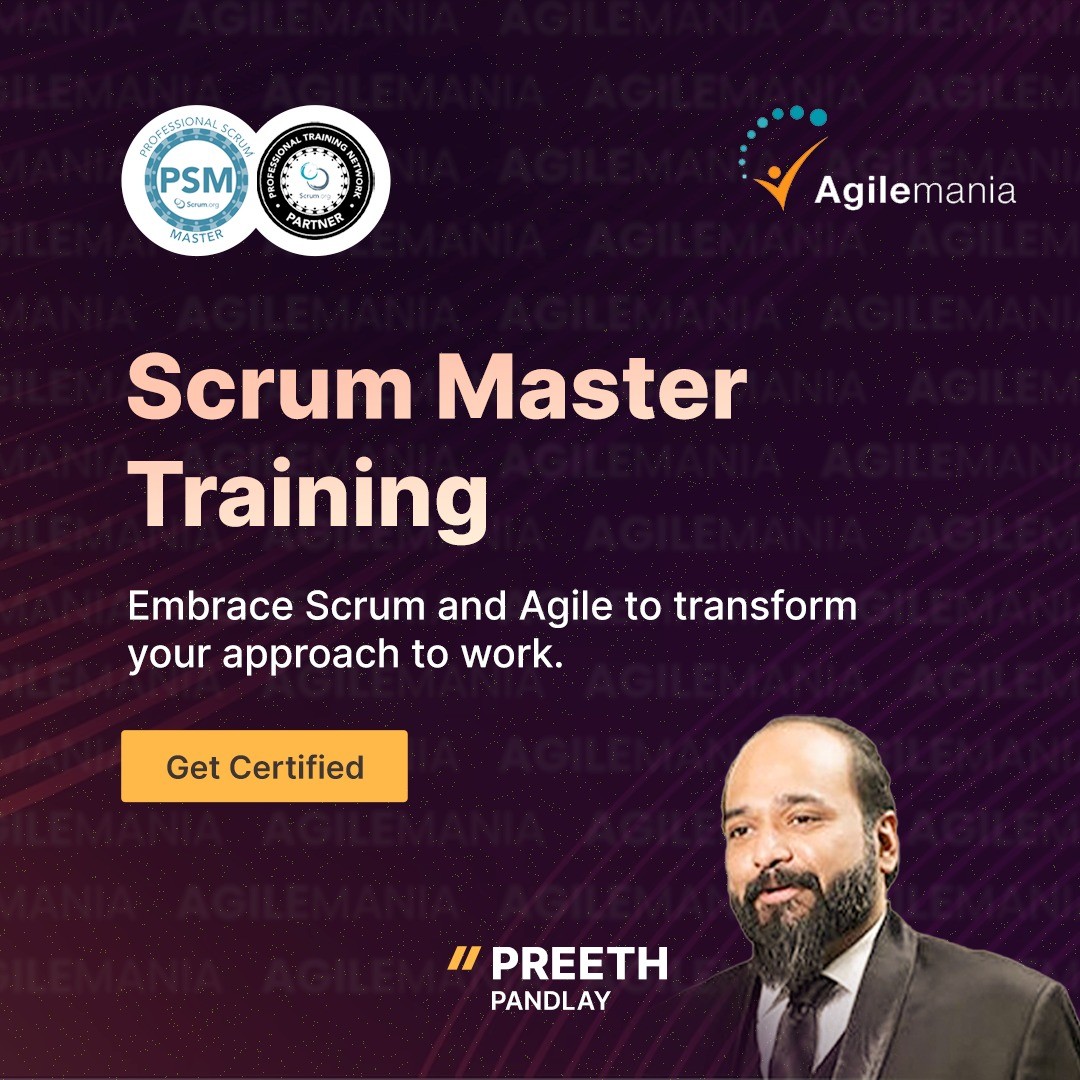
Agilemania
Agilemania, a small group of passionate Lean-Agile-DevOps consultants and trainers, is the most tru... Read more

Agilemania, a small group of passionate Lean-Agile-DevOps consultants and trainers, is the most tru... Read more
![Scrum Master Interview Questions and Answers 2024 [Updated]](jpg/post_1682574624.jpg)
A scrum master interview questions can be a tough nut to crack. Research and well-preparation is the key to crack a scrum interview successfully. Therefore, we have prepared a well-researched guide to scrum interview questions and answers to unlock the door to abundant job opportunities. Stick with us until the end to ace your next scrum interview. Read the following scrum master interview questions to make your next scrum interview a cakewalk.
User Story Mapping is a technique used in product ideation, like discovering a new product or new feature in an existing product. It can be used to identify MVP (minimum viable product).
Any Scrum team member can write the user stories. The team discusses the requirements during the primary stages and translates them into user stories. With the collective contribution of the team members, the requirements are clearly defined.
The 5 phases of risk management are as follows-
The techniques used for estimation in Scrum are-
Sprint 0 is the minimal effort to create a rough sketch of the product backlog. However, there is nothing called Sprint 0 in the Scrum Framework, so better to avoid connecting with Scrum. It consists of the understanding of the estimation of the release of the products. It is similar to the release planning or discovery phase of a product.
A Spike is an Enabler Story that checks out the viability of a proposed technical approach, gains the knowledge necessary to understand a requirement, or optimizes the reliability of a story estimate.
Scope creep refers to the continuous and uncontrolled changes that occur after the project begins. Scope creep can be handled through the below:
Definition of Done (DoD) is a checklist of items that need to be completed to declare a project or task as ‘Done.’ The checklist includes written codes, comments on coding, unit tests, integration testing, design documents, and release notes.
The acronym INVEST stands for Invest, Negotiate, Valuable, Estimable, Small, and Testable. It is a guide to writing good user stories.
Minimum Viable Product(MVP) is the prototype of a product with basic features released in the market so that early customers can use and provide critical feedback on the product. Minimum Marketable Product is the functional software that is ready for monetization. It consists of all the minimum essential features. It is ready to be launched in the market. It saves you the time of building the whole product with all functionalities. You can give the customers what they want.
Timeboxing refers to devoting a time slot to an activity. A timebox is a unit of time. A timebox should not exceed 15 minutes for Daily Scrum or 8 hours for Sprint Planning. Attend Professional Scrum Master training to learn the rules of timeboxing.
Curious about why you should consider getting a Scrum Master Certification? We have all you need to know, including who a Scrum Master is and their responsibilities.
Book Your Seat!
Using hours or days to estimate user stories may sound practical but isn’t so in reality. Here’s why-
Release Candidate is software that is yet to be developed in its final stage. It’s the preview of the software. The core focus of the release candidate is on the functionality, security codes, and quality.
The popular tools used in Scrum are-
Making daily stand-ups, a ritual will help the team members know the project's progress. The duration of the daily stand up meetings will differ according to the size and the level of experience-
Following a routine for far too long becomes monotonous. Conducting the sprint retrospective the same way will leave the scrum team tired. The Scrum Master can change things by conducting the sprint retrospective differently. The Scrum Master should make sure that the purpose of the retrospective is not lost in the quest to create a conducive environment for the retrospective. The Scrum Master serves the organization by leading, training, and coaching the organization in its Scrum adoption.
The Scrum Master is a management position, but it isn’t a manager position. The Scrum Master only manages the scrum process and not the team. Although the Scrum Master doesn’t have manager authority, they would resolve impediments.
The Scrum Master facilitates their decisions and eliminates hurdles of the development. Take note, the Scrum Master doesn’t manage the development team as they are responsible for their own management. The Scrum Master shields them from extrinsic troubles.
The three pillars of Scrum are-
Inspection - As a scrum user, you have to check things like your project's status and goals on a regular basis and analyze whether or not they are deviating from your expectations. Inspections should be done as often as you feel necessary, but it’s important to note that too many will become a burden. The ideal inspection is when an experienced person goes over everything with a fine-tooth comb at the point where it’s being done, i.e., the developer during development, the graphic designer at the completion of design, etc.
Adaption - If an inspector or inspector finds out that one or more parts of a process deviate beyond acceptable boundaries, the method or the material being processed must be modified because everything in a workflow should always strive to remain efficient and effective. Any problems should be looked into as soon as possible. That way, you can ensure that the same problem(s) will not occur again since it’s crucial when it comes down to getting your workflow and business up and running at peak efficiency.
Transparency - Transparency is essential when implementing a process in any sort of business. This prevents any miscommunication from occurring that could result in the product not meeting its intended criteria. It’s important for all participants working on the end goal to refer to their actions in the same terms.
As per the process, the Scrum Master is supposed to help the team get the best results. Acting as a facilitator for internal and external workshops can sometimes be challenging. A workshop facilitator must stay impartial while discussing topics and refrain from adding facts or opinions to the discussions. If you have the necessary expertise, you've got all it takes to facilitate most general product development workshops. However, if the workshop is about changing your company's Scrum process, you should not facilitate that session.
Action items are one among the primary outcomes of the retrospectives-
Scrum artifacts provide vital information to the Scrum team and stakeholders about the product that is being built. The following are the scrum artifacts-
The sprint retrospective is a time to reflect upon processes, the team, and anything else that could contribute to increased productivity. The entire Scrum team should be in attendance—including the Scrum Master, product owner, engineering team (including everyone who's designing, building, and testing the product), and any outsiders with a stake in its completion.
The product backlog is a list that contains and prioritizes the details of every little task you require to include in your product. If you want to make any changes to your product, then product backlog is the only source of requirements. Whereas, a Sprint Backlog is a list of tasks finalized by the Scrum team to work on during the current sprint.
Self-organized team member. Sprints allow you to inspect the progress and make adjustments that will move you closer towards your goals. A Scrum Master helps their team stay motivated and works with their other peers to ensure everything is going according to plan. Self-organization has a lot of perks- there's less structural planning or work which creates more freedom for everyone and allows them to decide on how best to achieve the Sprint goal.
A scrum of scrums is a scaled agile technique that helps organizations connect their multiple teams to develop and deliver complex solutions. To get something done efficiently, we need integrated teamwork and a way to do that is through transparency, inspection, and adaptation combined with agile techniques because if you focus on delivering value instead of working in silos you can scale your projects much more effectively.
Scrumban is an agile methodology which is the fusion of the best features of Scrum and Kanban.
Empiricism is a very important term when discussing Scrum. It is defined as work that’s based on facts, experiences, evidence, observations, and experimentation. Empiricism is used in Scrum to improve transparency by providing information about what has happened/happening within the team, as well as keeping track of progress and making any changes when require for observation purposes. Instead of relying on gut feeling or guesswork alone, empirical thinking improves with agile practices such as refactoring code in iterations for example.
Burndown chart is a visual representation of a graph that assesses how much work a development team has done through a user story. Burnup chart is a graph that shows the amount of the work done against the total project work.
The elements that constitute a good user story are-
Scrum requires individuals who are experienced with the format. Teams need to be collaborative and committed in order to guarantee that results are achieved. Those who aren't very familiar with the format can cause the termination of a project. While there may be a possibility for tasks to have inaccuracies, it is more optimal for smaller projects. It works well for small teams but scaling it up becomes difficult with larger projects that have many complexities in their makeup.
Prepare for your Scrum interview with expert tips and insights. Get ready to ace questions and showcase your skills confidently. Ace your interview with confidence!
Get ready for success now.
Velocity matters but it does not equal productivity. Your team’s attempt to raise their velocity may actually be detrimental if you’re not careful. If your time is short, a team might sacrifice unit or acceptance testing, reduce customer collaboration, fix less bugs, and other important factors required for agile development and deliverables. While there may be an advantage in doing this at first glance, these things will come back to haunt you down the line. You'll want to try and find your sweet spot over time which requires focusing on a variety of things that can help or hinder your progress such as end product quality and the know-how of your team.
"Servant leadership" is a type of leadership that focuses on maintaining trust and confidence. What’s great about this type of leadership is that it can apply to many situations, no matter what the industry or group may be. The scrum master needs to be a facilitator, a guide, and mentor/friend to all team members. As an example: facilitating meetings where they take notes on everyone's ideas, guiding team members through their error reports, mentoring them via one-to-one communication, anything that helps make each individual involved more empowered for the role in which they play.
The five values of Scrum are-
No. The entire team collaborates with stakeholders and subject matter experts during the product review. The Scrum Master is responsible for educating stakeholders in order to make sure they're communicating effectively with the rest of the team and that everyone is on the same page when it comes to getting things done by certain deadlines.
The team must create action items so that the retrospective is successful. To start this process, a simple way is to simply list everyone’s ideas. While listing, you can also tag anyone who is responsible for either tackling one of these tasks or figuring out what to do with them further. You should immediately move on from action item creation to discuss how each person’s idea can be used for product development and improvement.
Some things might seem like no problem, others may require additional discussion, or even others may not work as efficiently as intended. You should end up with tangible benefits from product development after going through the entire process since you will have researched the market needs and your target audience too.
Getting the scrum team involved in your project early on is beneficial because what we have to understand is this - agile methodology calls for breaking down the development process into small pieces, or sprints in the case of Scrum, which will require focused attention and regular feedback from all parties involved.
Epic: An Epic is a project that requires the definition of a Minimum Viable Product (MVP) and approval by Lean Portfolio Management before implementation. Because they have such large scope, it is necessary to define an MVP for this type of project to ensure its success. Stories: Story or User Story is a tool used in Agile to record the description of a software product from the end-user perspective.
These user stories are divided into small phases and then developed in single sprints by Agile teams. Tasks: Tasks refer to partitions of stories that are broken down to ease work. It is the smallest unit in Scrum that is used to denote work.
Sprint Review focuses on the product, while Sprint Retrospective focuses on the process. Sprint Review is concerned primarily with optimizing and maximizing product value, whereas Sprint Retrospective is involved with people, processes, and tools.
Agile |
Scrum |
| Agile is a development methodology that follows an incremental and developmental approach | Scrum is one of the frameworks of Agile. It follows an iterative and incremental approach called sprints which lasts 2-3 weeks |
| Agile works best for organizations which small but experienced development teams | Scrum is best suited for projects where requirements keep changing |
| Leadership plays a key role in Agile | Scrum supplements a self-organizing and cross-functional team |
| Lacks flexibility when compared to Scrum | Scrum’s flexibility is its biggest strength since it can adapt to changes quickly |
| Open communication is the norm in Agile where face to face interactions happen between cross functional teams | Daily stand up meetings are held where Scrum Master, Product Owner, and the team members |
| Agile needs a lot of structural and developmental changes before the start | Not many changes are required when applying Scrum |
| The client feedback loop should be regular in | The client is asked for feedback after every sprint for review |
| In Agile methodology, each phase of the development process like requirements, analysis, and design is tracked regularly | A demo is given to the client after every sprint for feedback |
| The Project head oversees the tasks and is the decision-maker | The team has no leader so the entire team resolves issues and tasks |
| Design and implementation should be simple | Innovation should drive design and implementation |
| Continuous delivery of the working product is the priority in Agile | Empirical process control is followed in scrum |
| Functional software is the measure of progress | Functional software is the measure of progress |
The Scrum Methodology consists of-
Agilemania, a small group of passionate Lean-Agile-DevOps consultants and trainers, is the most trusted brand for digital transformations in South and South-East Asia.
WhatsApp Us

We will get back to you soon!
For a detailed enquiry, please write to us at connect@agilemania.com
We will get back to you soon!
For a detailed enquiry, please write to us at connect@agilemania.com

